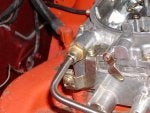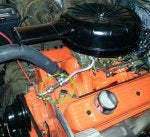I have always hated the thought of having a fuel filter plumbed inline between the mechanical pump and the carb, using rubber hose with clamps. Rubber hose is a potential failure point, and it just looks cheezy.
Because my car is a driver, with mostly a stock look, I didn't want to go the "Hot Rod" route and run fancy (and expensive) braided steel line with an inline AN-6 fuel filter. Most of those filters were too bulky and too long anyway. I wanted something shorter and smaller, something that could connect right up to the fuel pump outlet, without a bunch of adapters.
After doing lots of looking, I found this nice little inline 35 micron filter from Professional Products, part number 10211. It has an extruded aluminum housing, with 3/8" NPT female fittings on both sides, which allow me to only use one transition fitting per side.
http://professional-products.com/inline-fuel-filter-polished
My fuel pump has a 1/4" NPT outlet, so I stopped at my local hydraulics supplier and purchased a 1/4" to 3/8" NPT elbow. This threaded right into the pump on the one side, and right into the filter on the other. No additional reducers needed.
On the outlet side, I was able to use a Weatherhead 202x6x6 fitting, which is 3/8" NPT to 5/8" inverted flare for the 3/8" hard line to the Holley carb.
Because my car is a driver, with mostly a stock look, I didn't want to go the "Hot Rod" route and run fancy (and expensive) braided steel line with an inline AN-6 fuel filter. Most of those filters were too bulky and too long anyway. I wanted something shorter and smaller, something that could connect right up to the fuel pump outlet, without a bunch of adapters.
After doing lots of looking, I found this nice little inline 35 micron filter from Professional Products, part number 10211. It has an extruded aluminum housing, with 3/8" NPT female fittings on both sides, which allow me to only use one transition fitting per side.
http://professional-products.com/inline-fuel-filter-polished
My fuel pump has a 1/4" NPT outlet, so I stopped at my local hydraulics supplier and purchased a 1/4" to 3/8" NPT elbow. This threaded right into the pump on the one side, and right into the filter on the other. No additional reducers needed.
On the outlet side, I was able to use a Weatherhead 202x6x6 fitting, which is 3/8" NPT to 5/8" inverted flare for the 3/8" hard line to the Holley carb.























